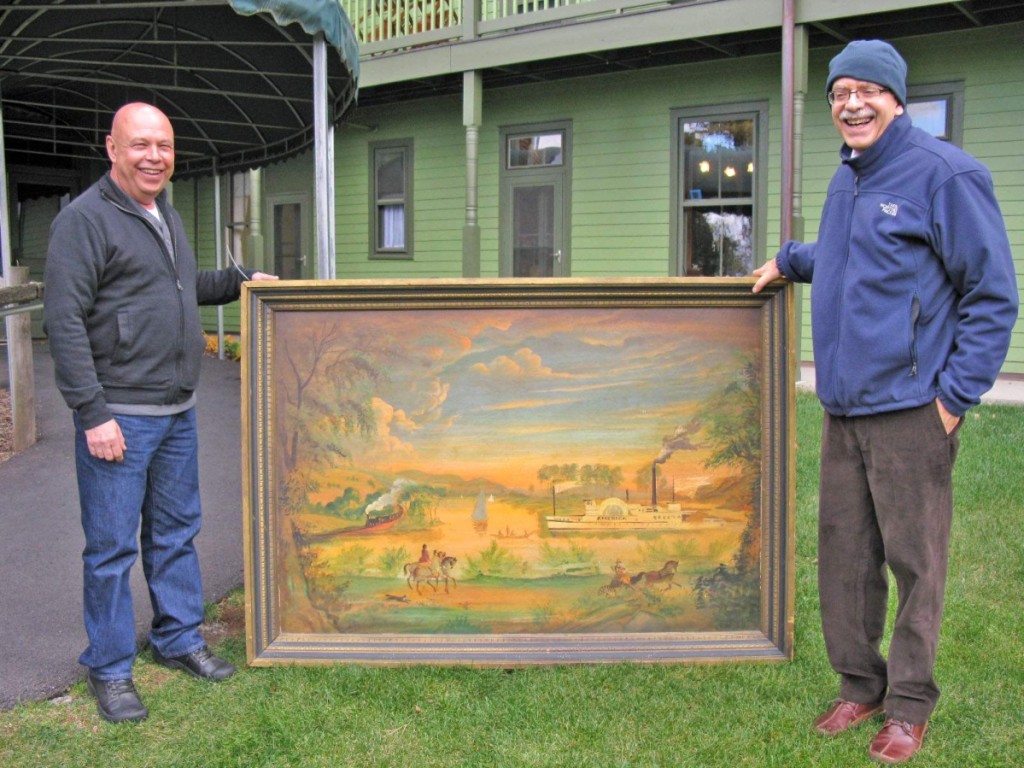 Sanford Levy, Jenkinstown Antiques owner in New Paltz, N.Y., has been collecting local Eighteenth and early Nineteenth Century furniture, fine art and decorative art for 45 years. He fills his show booth with them at Rhinebeck, and his home is furnished with them. You might say he is steeped in the art and lore of the area that was a magnet for Hudson River School artists, literary folks and visiting gentry for centuries. It is fitting that for years he has examined and appraised paintings held in the collection of Mohonk Mountain House, helping to identify artists and locales. Recently, he wrote the text for a new book, Paintings at Mohonk: Visions of Our Surroundings, a catalog of the 30 or so best works in Mohonk’s collection.
Sanford Levy, Jenkinstown Antiques owner in New Paltz, N.Y., has been collecting local Eighteenth and early Nineteenth Century furniture, fine art and decorative art for 45 years. He fills his show booth with them at Rhinebeck, and his home is furnished with them. You might say he is steeped in the art and lore of the area that was a magnet for Hudson River School artists, literary folks and visiting gentry for centuries. It is fitting that for years he has examined and appraised paintings held in the collection of Mohonk Mountain House, helping to identify artists and locales. Recently, he wrote the text for a new book, Paintings at Mohonk: Visions of Our Surroundings, a catalog of the 30 or so best works in Mohonk’s collection.
How did the idea for this book come about?
I’ve been selling paintings to the Smiley family for about ten years. About six years ago, I started appraising and writing up the paintings – taking them down, looking for signatures – and I wrote them all up first, but then Lou Petruzzelli, director of finance for the resort and a collector himself, suggested we start examining the collection. Working with Pril Smiley, the art director and a direct descendant of the founder Albert Smiley, who opened the mountain house in June 1870, the idea for the book was one we all decided on. I think the family’s love of the place is what gives it a unique character. It still has that family connection – there are the portraits of the family hanging in the parlors – and I believe the paintings of the area add to that.
What is the earliest work in the collection?
Possibly the earliest painting is one by an unknown artist that I describe in the book as “in the style of Thomas Cole,” who as you know was the founder of the art movement known as the Hudson River School. So this one, depicting a country lane to Mountain Lake, has all the hallmarks of the themes of a country terrain changed to accommodate human habitation.
The book has some interesting juxtapositions of period photographs alongside paintings depicting the same view.
The archives at Mohonk are truly incredible. Every time we found a photograph that depicted the exact spot in the painting, we were able to include that. There’s one in the catalog by Carl Werntz (1874-1944), “Shady Rock, ” where there are two women walking on the bridge over the Lemon Squeeze. The archivist Nell Boucher was able to find a photo of two women on the same bridge.
What’s an interesting personal tidbit about one of the artists that you learned about doing this project?
There’s a painting of “Lake Mohonk” by Henry Van Ingen (1833-1898). Somebody brought me that painting. The writing on the back was hard to read. It took me two weeks to figure that signature out. And then researching Van Ingen, I learned that he established the entire art department at Vassar College. In the archives at Mohonk we found letters from him where he spoke about the wonderful views, and there are guest registration entries showing his dinner companions. He invited people up there for dinner, including Vassar students, for about 30 years. To now see that painting there really brings it home – even though I bought it from somebody in the middle of New York state.

Sanford Levy and Lou Petruzzelli delivering a recent acquisition to add to the Mohonk artwork collection.
How did the Shawangunk region become a magnet for all these artists and sketchers whose works fill your book?
We probably have to give the credit to Thomas Cole and Daniel Huntington and all those early Hudson River artists who were traveling around and spreading the word that “this is beautiful.” I am certain that Van Ingen, with his connection to Vassar, must have influenced others as well. By the start of the Twentieth Century, roads and paths throughout the region improved and continued to attract visitors from afar.
Think I saw only one winter view in the book. Why is that?
We really don’t have any, except for Morris Hall Pancoast’s (1877-1963) “Covered Bridge in Winter.” And I don’t know why. The place was active all winter. Maybe the climb up to the hotel scared the artists away. It could get very bitter up there. I guess it just never happened. Someday, somebody will walk into my shop with a painting of Mohonk covered in snow. I hope so; it would be wonderful.
There is a tip-in that accompanies the book that, by artist and location, identifies where in the mountain house each painting or photograph can be seen. Neat idea.
I thought that was important because it’s not a gallery situation. The works are placed in different rooms, hallways and alcoves on four floors, and sometimes the lighting is challenging.
What’s your favorite view or vista?
I’d have to say – although I don’t climb up there every time – when you go up to Sky Top, the view of the Wallkill Valley is truly amazing. Gives you a real feeling for the area. And I can almost see where I live. I’ve lived here a long time and it’s become my whole interest – keeps me hunting for these local scenes.
-W.A. Demers




